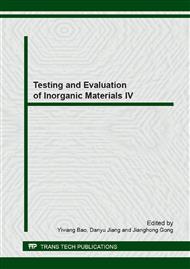[1]
G. M. Zhao, K.L. Wang, Effect of La2O3 on corrosion resistance of laser clad ferrite-based alloy coatings, Corros. Sci. 48 (2006) 273-284.
DOI: 10.1016/j.corsci.2005.01.002
Google Scholar
[2]
J.D. Majumdar, B.R. Chandra, A.K. Nath, I. Manna, Studies on compositionally graded silicon carbide dispersed composite surface on mild steel developed by laser surface cladding, J. Mater. Process. Tech. 203(1-3) (2008) 505-512.
DOI: 10.1016/j.jmatprotec.2007.10.056
Google Scholar
[3]
M. Green, M. Sharp, Exploiting laser technology in 21st century UK manufacturing: Linking laser materials processing applications to the driving forces for 21st Century manufacturing in the UK, The Association of Laser Users (AILU), Abingdon, (2010).
Google Scholar
[4]
A.J. Pinkerton, L. Li, Multiple-layer cladding of stainless steel using a high-powered diode laser: an experimental investigation of the process characteristics and material properties, Thin Solid Films. 453-454 (2004) 471-476.
DOI: 10.1016/j.tsf.2003.11.140
Google Scholar
[5]
M.X. Li, Y.Z. He, G.X. Sun, Laser cladding Co-based alloy/SiCp composite coatings on IF steel, Mater. Design. 25(4) (2004) 355-358.
DOI: 10.1016/j.matdes.2003.08.006
Google Scholar
[6]
A. Hirose, K.F. Kobayashi, Formation of hybrid clad layers by laser processing, ISIJ Int. 35(6) (1995) 757-763.
DOI: 10.2355/isijinternational.35.757
Google Scholar
[7]
S.J. Bull, A.M. Jones, A.R. McCabe, Residual stress in ion-assisted coatings, Surf. Coat. Tech. 54-55 (1992) 173-179.
DOI: 10.1016/s0257-8972(09)90046-9
Google Scholar
[8]
W.L. Song, J. Echigoya, B.D. Zhu, et al., Vacuum laser cladding and effect of Hf on the cracking susceptibility and the microstructure of Fe–Cr–Ni laser-clad layer, Surf. Coat. Tech. 126 (2000) 76-80.
DOI: 10.1016/s0257-8972(00)00532-6
Google Scholar
[9]
X.L. Wu, Rapidly solidified nonequilibrium microstructure and phase transformation of laser-synthesized iron-based alloy coating, Surf. Coat. Tech. 115(2-3) (1999) 153-162.
DOI: 10.1016/s0257-8972(99)00168-1
Google Scholar
[10]
X.L. Wu, G.N. Chen, Nonequilibrium microstructures and their evolution in a Fe-Cr-W-Ni-C laser clad coating, Mat. Sci. Eng. A 270 (1999) 183-189.
DOI: 10.1016/s0921-5093(99)00159-8
Google Scholar
[11]
J. Singh, J. Mazumder, Microstrcture and wear properties of laser clad Fe-Mn-C alloys, Metall. Trans. A 18 (1987) 313-322.
DOI: 10.1007/bf02825712
Google Scholar
[12]
K. Nagarathnam, K. Komvopoulos, Microstructural and Micro-hardness Characteristics of Laser- Synthesized Fe-Cr-W-C Coatings, Metall. Mater. Trans. A 26(8) (1995) 2131-2139.
DOI: 10.1007/bf02670684
Google Scholar
[13]
Q.M. Zhang, J.J. He, W.J. Liu, M.L. Zhong, Microstructure characteristics of ZrC-reinforced composite coating produced by laser cladding, Surf. Coat. Tech. 162(2-3) (2003) 140-146.
DOI: 10.1016/s0257-8972(02)00697-7
Google Scholar
[14]
W. Tan, W.J. Liu, J.H. Jia, Research on laser cladding Fe-C-Si-B, Heat Treat. Met. 25(1) (2000) 15-17.
Google Scholar
[15]
S. Li, Q.W. Hu, X.Y. Zeng, S.Q. Ji, Effect of carbon content on the microstructure and the cracking susceptibility of Fe-based laser-clad layer, Appl. Surf. Sci. 240 (2005) 63-70.
DOI: 10.1016/j.apsusc.2004.06.098
Google Scholar
[16]
S Wulin, Z Beidi, X Changsheng, H Wei, C Kun, Cracking susceptibility of a laser-clad layer as related to the melting properties of the cladding alloy, Surf. Coat. Tech. 115(2-3) (1999) 270-272.
DOI: 10.1016/s0257-8972(99)00249-2
Google Scholar
[17]
W.L. Song, J. Echigoya, B.D. Zhu, C.H. Xie, K. Cui, Effects of Co on the cracking susceptibility and the microstructure of Fe–Cr–Ni laser-clad layer, Surf. Coat. Tech. 138(2-3) (2001) 291-295.
DOI: 10.1016/s0257-8972(00)01168-3
Google Scholar
[18]
W.L. Song, B.D. Zhu, K. Cui, Effect of Ni content on cracking susceptibility and microstructure of laser-clad Fe-Cr-Ni-B-Si alloy, Surf. Coat. Tech. 80(3) (1996) 279-282.
DOI: 10.1016/0257-8972(95)02470-0
Google Scholar
[19]
G.M. Zhao, K.L. Wang Effect of La2O3 on resistance to high-temperature oxidation of laser clad ferrite-based alloy coatings, Surf. Coat. Tech. 190 (2005) 249-254.
DOI: 10.1016/j.surfcoat.2004.08.203
Google Scholar
[20]
I. Manna, J. D. Majumdar, B.R. Chandra, et al., Laser surface cladding of Fe-B-C, Fe-B-Si and Fe-BC-Si-Al-C on plain carbon steel, Surf. Coat. Tech. 201 (2006) 434-440.
DOI: 10.1016/j.surfcoat.2005.11.138
Google Scholar
[21]
X.L. Wu, Y.S. Hong, Fe-based thick amorphous-alloy coating by laser cladding, Surf. Coat. Tech. 141 (2001) 141-144.
DOI: 10.1016/s0257-8972(01)01263-4
Google Scholar


